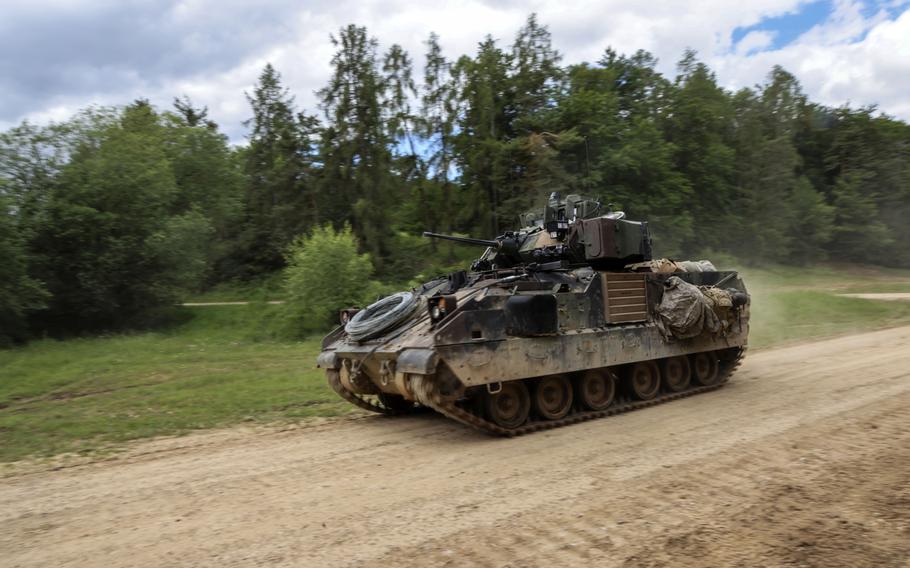
A U.S. Army M2 Bradley infantry fighting vehicle during a training exercise in Germany in June. (Alex Kraus/Bloomberg)
It feels ghoulish to look for good news in Russia’s war in Ukraine, given how much misery that conflict has inflicted. But geopolitical tragedies can serve pedagogical purposes. If nothing else, this war has illustrated what a world without American power would look like — and what it looks like when America uses that unmatched power well.
My day job involves teaching Johns Hopkins University undergrads and grad students about international relations. I periodically have to remind myself that one can forgive millennials and members of Gen Z for having a jaded view of America’s global role.
For two decades, the standout events in U.S. foreign policy were costly, failed wars in Iraq and Afghanistan. If you’re not old enough to remember the reunification of Germany in 1990 or the Persian Gulf War of 1990-91, you may struggle to think of an international mega-crisis Washington managed with aplomb.
This isn’t to give credence to overwrought critiques of American statecraft in the two decades after the Cold War. Many foreign policy successes are invisible, because they involve preventing awful outcomes — perhaps additional, catastrophic terrorist strikes after 9/11; or a global depression in 2008-09 — as well as achieving good ones.
But if your consciousness of U.S. foreign policy is bookended by the Iraq invasion in 2003 and the humiliating withdrawal from Afghanistan in 2021, you might wonder whether Washington really knows what it is doing. And if you grew up in a post-Cold War world where the global wars and vicious rivalries of the 20th century seemed like ancient history, you might ask what the value of the American-led international order really is.
The Ukraine War has been doubly enlightening. First, it starkly illustrates just how grim and brutal a post-American world might be. A Ukraine left to its own devices would have quickly succumbed to President Vladimir Putin’s invasion. It would now be suffering show trials, the execution and imprisonment of its leaders, and harsh punishment of anyone who resisted Russian rule.
The reason so many Eastern European countries have clamored to get into America’s alliance network over the past 25 years is that they understand that the sort of aggression and barbarism we have seen in Ukraine have been the norm for much of human history. Such outrages have simply been suppressed, to an unprecedented degree, by America’s self-interested but comparatively benign leadership since World War II.
Fortunately, the Ukraine war has also offered a timely case study in just how mighty and effective an engaged America can be. President Joe Biden’s administration hasn’t gotten everything right: Its early assessments of Ukraine’s will to fight were far too pessimistic, for instance, and its initial efforts to deter Russian nuclear escalation were muddled and confusing. But the overall performance has been pretty good, helping Ukraine thrive in a war it wasn’t supposed to survive, and demonstrating that the world won’t be truly multipolar anytime soon.
The U.S. intelligence community usually makes news when it gets things wrong. But what other country has an intelligence establishment that could have gotten so much right about events half a world away?
America’s spies sniffed out Putin’s aggression months in advance and gave Ukraine critical warning on how the invasion would unfold. The U.S. has delivered real-time information that has allowed Kyiv to plan its most effective offensives and carry out its most spectacular strikes. That performance is presumably not lost on President Xi Jinping of China, who now must worry that any bid to attack Taiwan might quickly become the worst-kept secret on earth.
The war is also a testament to the influence America’s global alliance network provides: Washington rallied dozens of advanced democracies in multiple regions to support Ukraine and sanction Russia.
That response, in turn, has advertised America’s capacity to inflict economic pain. The sanctions and export controls that Washington and its friends have imposed may not force Putin out of Ukraine, but they will force his country into a future of stagnation and technological backwardness.
Then there is the contrast between Russian military gear — tanks that combust catastrophically when hit, missiles that don’t get close to their targets — and American military equipment. By providing just 20 HIMARS rocket launchers, Washington helped Kyiv turn the tide of Europe’s largest land war since 1945; one wonders how much damage Ukraine might be doing with 40 of them instead.
None of this slights the performance of the Ukrainians, whose skill, resilience and creativity have been simply awesome. But even here, the war is a useful antidote to some recent American pessimism: Contrary to what one may have thought after the dispiriting denouement in Afghanistan, some U.S. security partners are quite competent and committed after all.
Overconfidence can be deadly, and what has happened in Ukraine is no guarantee that Washington will succeed in the next crisis with Beijing, Moscow or Tehran. But a war in which the U.S. is not even directly involved has provided a vital lesson for America and its rivals: There’s still just one superpower.
Bloomberg Opinion columnist Hal Brands is the Henry Kissinger Distinguished Professor at Johns Hopkins University’s School of Advanced International Studies, co-author of “Danger Zone: The Coming Conflict with China” and a member of the State Department’s Foreign Affairs Policy Board. This column does not necessarily reflect the opinion of the editorial board or Bloomberg LP and its owners.